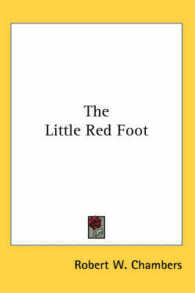- ホーム
- > 洋書
- > 英文書
- > Science / Mathematics
Full Description
Life Span Motor Development, Sixth Edition With Web Study Guide, uses the model of constraints in discussing reasons for changes in movement throughout the life span, Focusing on assessment more heavily than previous editions, this updated edition encourages students to examine how the interactions of the individual, environment, and task bring about changes in a person's movements. The principles of motor development are presented in an accessible manner so that even readers with minimal movement science background will comprehend the material. A key component of the sixth edition is an improved web study guide featuring revised lab activities and better functionality. New to this edition, lab activity record sheets and questions are available as fillable documents so that students can complete and submit them electronically, resulting in increased efficiency and reduced paperwork for instructors. In several labs, guided assessments teach students to observe video and categorize movements accurately. These assessments cue students to look at particular parts of the movement and guide students through questions, answers, and feedback. Then students are provided opportunities for unguided assessments via video clips or live observation, putting into practice what they have learned in the guided assessments. There are also over 100 new video clips in the web study guide, including a comprehensive video diary of the motor development milestones in the first nine months of a baby's life. Life Span Motor Development, Sixth Edition, contains several other updates that are appealing to instructors and students alike: * A new full-color interior provides for a more engaging presentation of the material. * Updated research includes Generation R studies and connections to fitness and motor skills. * An updated presentation package and image bank, plus a test package and chapter quizzes, are included. * An instructor guide includes recommendations on using the lab activities in the web study guide both in and out of class. * Multiple learning exercises that were previously part of the web resource have been moved to the book to allow the video-rich lab activities to occupy students' learning time when they are online As in past editions, students understand how maturational age and chronological age are distinct and how functional constraints affect motor skill development and learning. It also covers normal and abnormal developmental issues across the full life span, especially in the formative years. The text shows how the four components of physical fitness-cardiorespiratory endurance, strength, flexibility, and body composition-interact to affect a person's movements over the life span. It also describes how relevant social, cultural, psychosocial, and cognitive influences can affect a person's movements. Significant updates focus on assessment, including new figures that help to explain in detail the functional constraints approach to assessment. Life Span Motor Development, Sixth Edition, not only provides students with the observational skills necessary for assessing motor development, but it also expertly ties the information to real life. The text continues to emphasize the application of motor development concepts to the real world by beginning each chapter with an example of a common experience and then revisiting that experience at the end of the chapter, allowing readers to apply the material to the example. The book also retains the objectives; running glossary; and key points, sidebars, and application questions throughout each chapter. Life Span Motor Development, Sixth Edition, encompasses the most current research in motor development. It is enhanced with practical online resources for instructors and students, making the concepts of motor development come alive. The text gives students a solid foundation not only for beginning their studies in motor development but also for applying the concepts to real-world situations.
Contents
Part I. Introduction to Motor DevelopmentChapter 1. Fundamental Concepts Defining Motor Development Constraints: A Model for Studying Motor Development How Do We Know It Is Change? A Developmental Paradox: Universality Versus Variability Summary and Synthesis Chapter 2. Theoretical Perspectives in Motor Development Maturational Perspective Information Processing Perspective Ecological Perspective Summary and Synthesis Chapter 3. Principles of Motion and Stability Understanding the Principles of Motion and Stability Using the Principles of Motion and Stability to Detect and Correct Errors Summary and Synthesis Part II. Physical Growth and AgingChapter 4. Physical Growth, Maturation, and Aging Prenatal Development Postnatal Development Summary and Synthesis Chapter 5. Development and Aging of Body Systems Development of the Skeletal System Development of the Muscular System Development of the Adipose System Development of the Endocrine System Development of the Nervous System Summary and Synthesis Part III. Development of Motor Skills Across the Life SpanChapter 6. Early Motor Development How Do Infants Move? Why Do Infants Move? The Purpose of Reflexes Motor Milestones: The Pathway to Voluntary Movements Development of Postural Control and Balance in Infancy Summary and Synthesis Chapter 7. Development of Human Locomotion The First Voluntary Locomotor Efforts: Creeping and Crawling Walking Across the Life Span Running Across the Life Span Other Locomotor Skills Summary and Synthesis Chapter 8. Development of Ballistic Skills Overarm Throwing Kicking Punting Sidearm Striking Overarm Striking Summary and Synthesis Chapter 9. Development of Manipulative Skills Grasping and Reaching Catching Anticipation Summary and Synthesis Part IV. Perceptual-Motor DevelopmentChapter 10. Sensory-Perceptual Development Visual Development Kinesthetic Development Auditory Development Intermodal Perception Summary and Synthesis Chapter 11. Perception and Action in Development The Role of Action in Perception Postural Control and Balance Summary and Synthesis Part V. Functional Constraints to Motor DevelopmentChapter 12. Social and Cultural Constraints in Motor Development Social and Cultural Influences as Environmental Constraints Society and Socialization as Environmental Constraints Other Sociocultural Constraints: Race, Ethnicity, and Socioeconomic Status Summary and Synthesis Chapter 13. Psychosocial Constraints in Motor Development Self-Esteem Motivation Summary and Synthesis Chapter 14. Knowledge as a Functional Constraint in Motor Development Knowledge Bases Memory Speed of Cognitive Functions Summary and Synthesis Part VI. Interaction of Exercise Task and Structural ConstraintsChapter 15. Development of Cardiorespiratory Endurance Physiological Responses to Short-Term Exercise Physiological Responses to Prolonged Exercise Summary and Synthesis Chapter 16. Development of Strength and Flexibility Development of Strength Development of Flexibility Summary and Synthesis Chapter 17. Development of Body Composition Body Composition and Exercise in Children and Youth Body Composition and Exercise in Adults Obesity Summary and Synthesis Chapter 18. Conclusion: Interactions Among Constraints Using Constraints to Enhance Learning in Physical Activity Settings Interacting Constraints: Case Studies Summary and Synthesis








